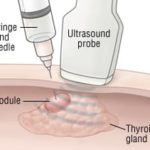1. In this systematic review and meta-analysis that included 16,597 patients, fine needle biopsy (FNB) sensitivity was approximately 86%, and specificity was approximately 71%.
2. The diagnostic accuracy of FNB did not change significantly over time.
Evidence Rating Level: 1 (Excellent)
Study Rundown: Fine needle biopsy (FNB) has been an important component of thyroid nodule diagnosis and workup since the 1970s. Patients that present with concerning thyroid nodules upon ultrasound are commonly referred for FNB to examine the pathology further. There is limited evidence on how the diagnostic accuracy of FNB has changed since it has become a critical part of thyroid nodule evaluation. The objective of this study was to conduct a systematic review and meta-analysis to estimate the sensitivity and specificity of FNB for diagnosing thyroid malignancies in adults and to characterize its changes in accuracy over time. The primary outcome was the accuracy of FNB diagnosis of malignancy. Databases PubMed, SCOPUS, and Cochrane Central Register of Controlled Trials were searched, and a total of 36 of 1023 studies met the inclusion criteria. The sensitivity of FNB was found to be 85.6%, the specificity 71.4, the positive likelihood ratio was 3.0, and the negative likelihood ratio was 0.2. These findings indicate that the diagnostic accuracy of thyroid FNB has not significantly changed over time. As such, FNB remains a reliable test for thyroid cancer. A major strength of this study is that it is the largest to date regarding the diagnostic utility and reproducibility of FNB for thyroid nodules. A limitation was that all studies included were observational; therefore, the meta-analysis is subject to selection bias.
Click to read the study in JAMA Surgery
Click to read an accompanying editorial in JAMA Surgery
Relevant Reading: Appropriate and accurate diagnosis of thyroid nodules: a review of thyroid fine-needle aspiration
In-Depth [systematic review and meta-analysis]: This study, including 16,597 patients from 36 studies (mean [SD] age 47.3 [12.9 years]; 79.2% female), evaluated the diagnostic accuracy of thyroid FNB for diagnosing thyroid malignancy and how it has changed over time. PubMed, SCOPUS, and Cochrane Central Register of Controlled Trials databases were searched from 1975 to 2020 using search terms related to thyroid FNB accuracy. Study inclusion criteria consisted of English-language reports of cohort studies or randomized controlled trials of patients undergoing thyroid FNB with a sample size greater than 20. All included studies used a prospective or retrospective cohort design. A total of 36 of 1023 studies met the inclusion criteria. The sensitivity of FNB was 85.6% (95% CI, 79.9-89.5), the specificity was 71.4% (95% CI, 61.1-79.8), the positive likelihood ratio was 3.0 (95% CI, 2.3-4.1), and the negative likelihood ratio was 0.2 (95% CI, 0.2-0.3). The area under the receiver operating characteristic curve was found to be 86.1%. A total of 13.4% (95% CI, 6.0-26.5) of inconclusive FNB were ultimately found to be malignant. Epoch was not significantly associated with bivariate diagnostic accuracy.
Image: PD
©2022 2 Minute Medicine, Inc. All rights reserved. No works may be reproduced without expressed written consent from 2 Minute Medicine, Inc. Inquire about licensing here. No article should be construed as medical advice and is not intended as such by the authors or by 2 Minute Medicine, Inc.


